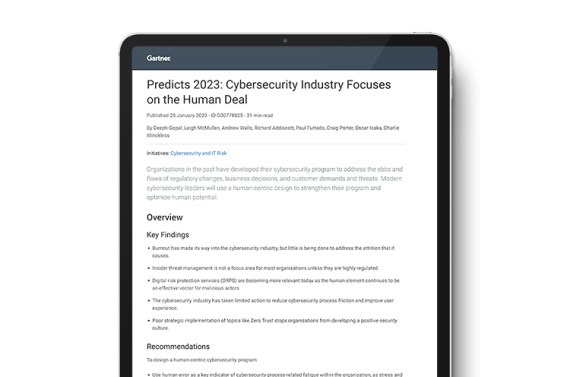“By 2025, lack of talent or human failure will be responsible for over half of significant cyber incidents.” How can a human-centric design strengthen your cybersecurity program? Get your report to learn from key predictions, market implications, and recommendations.

An effective third party cyber risk management program both identifies potential threats and finds ways to mitigate them. Organizations should aspire to the highest possible standards when it comes to their security posture. To do so, they must leverage the best technology, efficiently allocate resources, and strive for continual improvement.
Here are three ways to guide your third party cyber risk management program toward best-in-class status.
Implement Security Ratings
Many IT leaders pride themselves on setting high cybersecurity standards and enacting policies and infrastructure that serve this goal. This same level of control, however, is impossible when trying to oversee third party vendor security policies.
Traditional vendor assessment techniques, like doing on-site visits or sending a security risk assessment questionnaire, are not scalable to the large number of critical third parties that most organizations partner with. To ensure best-in-class cyber risk management, organizations should access information from firms that specialize in analyzing and rating vendor security postures. These security rating platforms, like Bitsight, use proprietary algorithms to continually assess a company’s security posture and provide corresponding ratings.
Security ratings offer many advantages. Instead of simply looking at a vendors’ cybersecurity posture at a specific point in time, they provide continuous monitoring. Also, unlike with questionnaires, which can be biased or inaccurate, security ratings are objective measurements of a company’s security posture.
Most importantly, security ratings provide a quantifiable measurement of a firm’s security capabilities, making it easier for organizations to make better-informed risk decisions. This also makes it easier to monitor vendor risk over time, and receive notifications when risk levels cross boundaries set by your company.
Allocate Sufficient Resources
One of the biggest struggles with vendor management programs is securing sufficient resources to make them effective. For some organizations, risk management in IT is based on minimizing costs and focuses on compliance-driven concerns. It can be difficult to make the business case for more advanced IT risk management that aligns with the broader business goals of the company, especially as it relates to third parties.
Nevertheless, it’s imperative to allocate sufficient resources for these challenges. Vendor risk is a very real concern, and data breaches commonly occur because of inadequate third party security.
Gartner Predicts: Cybersecurity Industry Focuses on the Human Deal: Gartner

Gartner Predicts: Cybersecurity Industry Focuses on the Human Deal: Gartner
Thankfully, security ratings like those from Bitsight can be used to help organizations optimize resource allocation and reduce vendor risk. Because security ratings are automated, your risk management team can monitor and assess a much larger number of vendors compared with the exclusive use of traditional, manual processes and tools.
Still, even with security ratings, the third party risk management program needs proper resources in order to make sure the organization’s most critical information is secure. That means the executive team needs to provide enough financial, human, and technological resources to the risk management team so they can regularly assess, monitor, communicate with, and remediate problems with vendors.
Create Realistic Plans-of-Action
In the past, it was difficult for vendor risk teams to effectively quantify third party risk. They may have done assessments of vendors, but the results were often more qualitative than quantitative. Unless the team developed their own comprehensive scoring system, it was difficult to do comparison or track changes over time. All of this made setting goals difficult.
Without a clear metric to reach, it’s difficult to know when you’ve achieved an intended result — and risk professionals know that vague objectives like “reducing risk among IT services vendors” are not going to be effective.
Security ratings help eliminate this uncertainty. They enable the creation of hard and fast objectives based on defined metrics. Each firm can decide on score thresholds that warrant action, and the security ratings provider will also provide insight about what a particular score means.
Organizations that use security ratings can set overall goals like having a particular security rating average across all vendors. They can also analyze and set more granular goals based on category-specific metrics, like a certain vendors’ botnet score.
Bitsight Security Ratings can be broken down in this kind of detail, providing clear evidence of where a vendor is falling short of expectations. Having specific information at your disposal makes it easier to communicate with vendors and establish clear goals that they must meet.
Bitsight rating requirements can even be built into new vendor contracts. Using Bitsight as your main resource for vendor risk assessments gives you greater leverage in dealing with your vendors and ensuring their security measures are up to par.